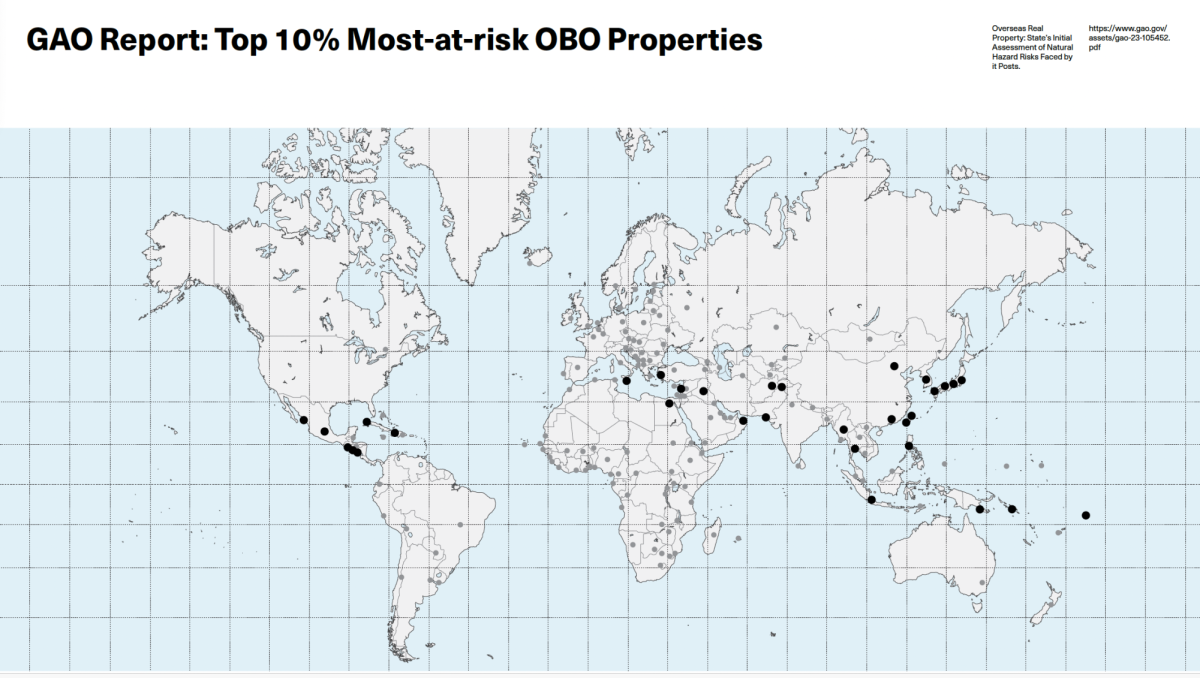Northwestern civil and environmental engineers have worked in collaboration with the U.S. Department of State Bureau of Overseas Buildings Operations and Chicago architecture firm Krueck Sexton Partners for the past five years to plan for the future of U.S. embassies and consulates.
“The way in which we design cities is really founded in principles and approaches of the 20th century, not the 21st century, and they’re predicated on very cheap energy and certain materials and certain design principles,” McCormick Prof. Kimberly Gray said. “We’re not designing in any way that’s responsive to a rapidly changing climate. We don’t design in a way that’s adaptive for change, resilient to extreme events, or sustainable.”
The project focused on decarbonizing embassies, preparing for natural and coastal hazards, using local materials, and making embassies more energy efficient, Gray said.
She said the project did not focus on select embassies but instead took a general approach. Embassies are designed for security, diplomacy and stewardship, which engineers have to keep in mind, Gray said.
“They wanted embassies to promote the innovation and the democratic spirit of the United States to be a symbol afar, and for us to build partnerships with host countries,” Gray said. “Security in the future, mid-century, may not be security from a terrorist. It may be security against a rapidly changing climate or extreme events.”
Gray said the project suggested the bureau move from a code-based design to a performance-based one, which would determine how an embassy is built based on local conditions and design space. She said the project also urged the bureau to build new buildings with carbon-negative goals.
When Gray presented the project to the bureau, the bureau was hesitant to implement it because of the enormous resistance against addressing climate change, she said.
“I made presentations to the ambassadors, and all of a sudden they were like, ‘Oh, this is great,’ but we can’t let anyone know we’re doing it because (of) the House — because there’s enormous denial in Congress about climate,” Gray said.
McCormick Prof. Gianluca Cusatis, who worked on the project, said his focus within the project was on selecting infrastructure materials.
Cusatis said his main recommendation for the project was for the bureau to establish a versatile design process that can be replicated with local materials.
“Use of local material was the one thing that we identified as one of the primary things that they should pursue,” Cusatis said. “Whenever you have to move material from one place to another, even if that is the best material for both the loading conditions, the cost and the environment, if you have to move it thousands of miles, you lose most of the benefit because of the transportation.”
Currently, embassies treat water with the standard of drinking water, McCormick Prof. George Wells said. Wells suggested the embassies treat the water at various levels depending on its use instead, which would be more resilient than highly centralized water systems.
Wells focused on the water systems of the embassies for the project. In particular, he said the water systems within embassies should shift towards decentralized, modular water treatment and reuse systems.
“The vision for the future that we propose for embassies is tailored to the State Department needs, but it’s also a vision that I think is highly applicable to decentralized and sustainable management of water and energy in cities or communities in general around the world,” Wells said.
There are two goals to focus on for the building science side of things, said McCormick Prof. Giorgia Chinazzo. Building science emphasizes how buildings can be designed to operate efficiently.
Chinazzo said it is essential to focus on not just technology but also the occupants, which can include using personalized comfort devices that finetune personal space for comfort and health.
“People think that the more energy you spend, the better you feel, but it’s not always the case,” Chinazzo said. “You just need to make more choices and implement the right technologies in your building, and then you can actually achieve both.”
Though the project was completed in 2023, Gray said the project could not be released until this year because of security clearance issues. The project was published in a book that detailed the completed research.
Email: [email protected]
Related Stories:
— MSAB’s Engineering Week celebrates McCormick students and clubs
— Meet Concrete Canoe, the engineering club learning to make concrete float






